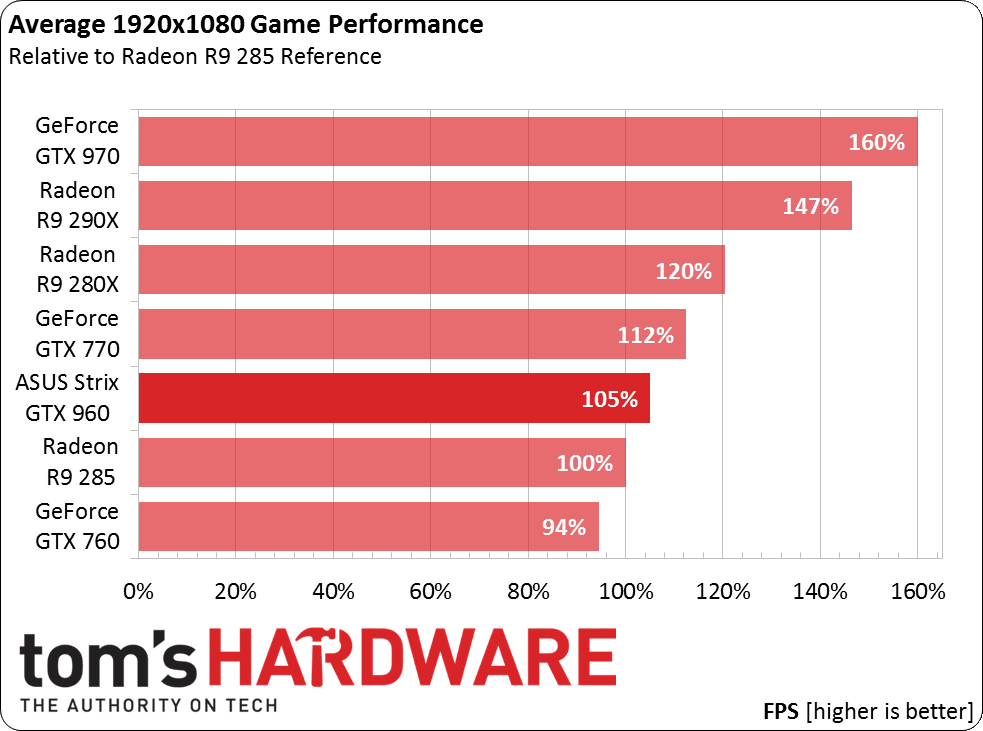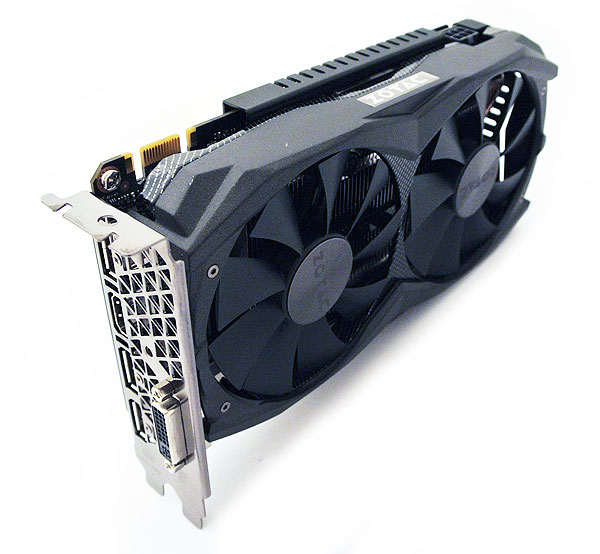Nvidia GeForce GTX 960: Maxwell In The Middle
Maxwell’s Efficiency Arrives At The Mid-Range
Before we talk about Nvidia's GeForce GTX 960, let’s recap the 1080p benchmark results (we aren't including the 4K numbers because they're a stretch for this class of card). Bear in mind that we didn't test a reference card for today's launch. The product representing GeForce GTX 960's performance is Asus’ Strix, a board with a significant 135MHz factory overclock and, more notably, a 140W power target instead of the reference 120W specification.
On average, Asus' factory-overclocked Strix GTX 960 performs 5% better than a Radeon R9 285, and a little closer to the GeForce GTX 770 than the 760. A reference-clocked GeForce GTX 960 would have been slower than Asus' specimen, which could have made it slightly slower than, but still competitive with, a reference-clocked Radeon R9 285.
The Radeon R9 285 sells on Newegg between $210 and $260, and the GeForce GTX 960’s MSRP of $200 is notably less. Most of the models we've seen with lofty factory overclocks are expected to land around $210. With average performance so close, though, other factors come into play when picking a favorite. The most obvious difference is that the GeForce GTX 960 offers better efficiency than the Radeon, which is a boon in small cases. The second main differentiator is Nvidia’s MFAA technology, which does a good job of increasing anti-aliasing quality while minimizing the performance impact compared to MSAA. Finally, I continue to be surprised at the increasing popularity of recorded video game footage. ShadowPlay does an exceptional job of enabling this use case without negatively affecting performance. I've recommended GeForce GPUs to friends based on this feature alone.
To be fair, AMD’s Raptr-enabled GVR video recording software is significantly better than Fraps, but it’s just not as efficient as ShadowPlay. Nvidia offers G-Sync monitor support today, too (though we’d be remiss if we didn’t mention that AMD-compatible FreeSync-capable displays are expected soon). MOBA players will appreciate what DSR can do on a GeForce card. However, AMD has an answer to that with its recently-released VSR feature. And of course, there’s AMD’s Mantle API to think about as well. We just wish more titles supported it.
As performance purists, it’s rare that we recommend a graphics card based on features. But if power usage matters to you, the GeForce GTX 960 is the right choice. If you record a lot of your online exploits, Nvidia’s ShadowPlay recorder is the best option out there. And if the GeForce MFAA implementation suits your fancy, it’s a great way to increase anti-aliasing quality without sacrificing frame rates. None of those options change the competitive landscape like the GeForce GTX 970’s disruptive price tag did when it was launched, but they do make the GeForce GTX 960 a lot more interesting up against AMD's Radeon R9 285. When you consider the fact that you can get a factory-overclocked GeForce GTX 960 for $210, there's even less reason to look elsewhere.
Get Tom's Hardware's best news and in-depth reviews, straight to your inbox.
Current page: Maxwell’s Efficiency Arrives At The Mid-Range
Prev Page Noise Level And Frequency AnalysisDon Woligroski was a former senior hardware editor for Tom's Hardware. He has covered a wide range of PC hardware topics, including CPUs, GPUs, system building, and emerging technologies.
-
Novuake This seems meh... Impressive but not phenomenal power consumption to performance numbers. Especially compared the GTX970/980.Reply
Would have liked to see two more things.
1. More extensive AA. post processing and memory bandwidth testing. Pretty sure Nvidia hamstrung the card a bit in some scenarios with a 1280bit interface. I had to read it 4 times before I believed it and still am skeptical.
2. Overclocking benchies.
So otherwise I guess we are back to the "old" ti-designation setup where the GTX960ti SHOULD be based on GM206 and vanilla GTX960 is not. -
sconzen I may be blind, but I don't see the Zotax Amp! edition in the temperature and noise tests. Confirm?Reply -
damric The R9 280 is the fast and cheap elephant in the room that was never mentioned in this review,Reply -
Grognak Well, I'm not saying a 10% improvement on top of a reduced power consumption isn't nice, because it really is, however we're still quite far away from the 770. I suppose Nvidia has a card planned to fill the massive performance gap between the 960 and 970, one at 4Gb of VRAM maybe?Reply -
sconzen I may be blind, but I don't see the Zotax Amp! edition in the temperature and noise tests. Confirm?Reply -
Novuake Reply15117694 said:The damn arrows are STILL blocking the charts!
I am not the only one! Thank you! -
ykki Novoake, I am very sorry but I stole your comment from an earlier review.Reply
But seriously, those arrows can block out the sun if tom's put 'em right.

